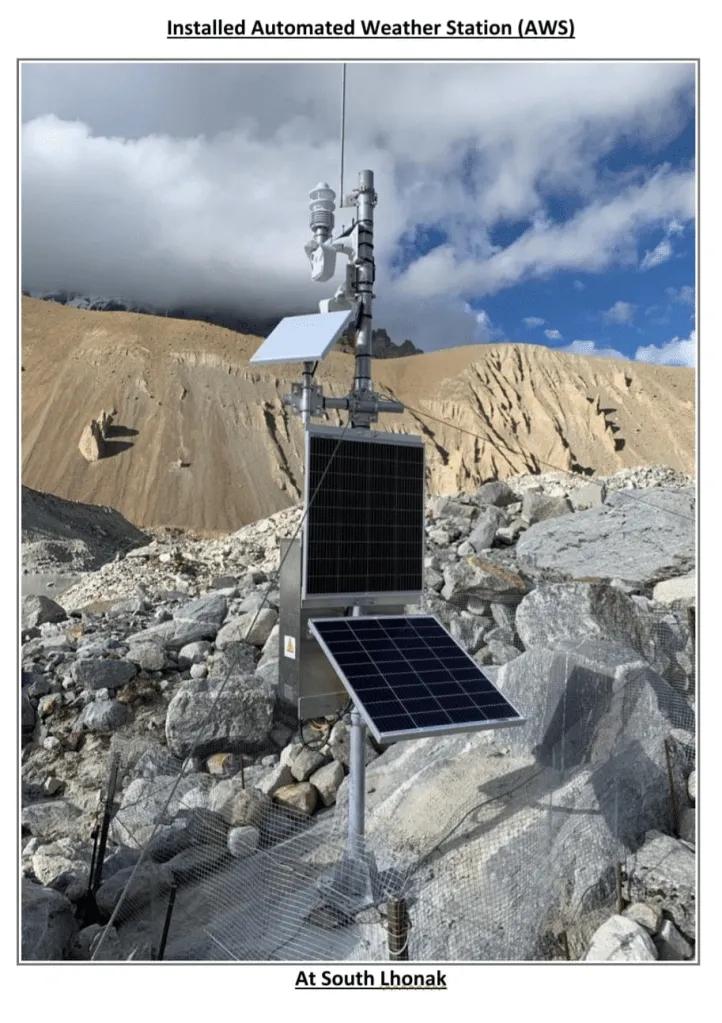One of the two solar-powered twin-camera and automated weather stations that they installed at two high-risk glacial lakes in Sikkim stopped transmitting signals three days after installation in September.
Two NDMA-led multi-agency teams installed these on September 16, days before excess rainfall and a Glacial Lake Outburst Flood (GLOF) caused a flash flood in north Sikkim on October 3.
“Two NDMA-led multi-agency expeditions to two high-risk glacial lakes, South Lhonak and Shako Cho in Sikkim, located at a height of 15000-16,000 feet, installed two solar-powered, twin-camera, automated weather stations on September 16, 2023,” a statement issued by the National Disaster Management Authority (NDMA) said.

Considering the remote location, harsh climate, terrain and topography, and the installation of an unmanned system, we needed to make considerable preparations to ensure the safety and functionality of the stations.
“NDMA issued a statement emphasizing the immense preparations required due to extreme conditions, rugged terrain, and unmanned station installation to ensure the safety and functionality of these weather stations.”
Not only did this mission succeed in identifying suitable installation sites and setting up the automated weather stations, but it also laid the groundwork for a comprehensive early warning system. During a subsequent expedition, it identified potential locations for sensor installation and recommended mitigation measures for future operations.
GLOF risk mitigation Programme expansion
Daily, one set of camera views and over 250 weather observations were received. However, after September 19, the equipment at South Lhonak stopped transmitting, according to a statement.
On September 28, an Indo-Tibetan Border Police (ITBP) team inspected the equipment and determined its physical stability, but they couldn’t restore it to operation.
The Shako Cho equipment continues to send data daily. The enclosed images and data are from this equipment.
They plan to expand the GLOF Risk Mitigation Programme to high-risk glacial lakes in India.
The installation of the AWS involved several organizations including NDMA, the Sikkim government, the Indian Army, ITBP, CWC, GSI, NCPOR, NRSC (ISRO), DGRE, CDAC, SOI and SDC (Swiss Agency for Development and Cooperation), as per the statement.
The flash flood in Sikkim has resulted in 37 fatalities, including 10 Army soldiers. Additionally, 78 people are still missing as reported by the State Disaster Management Authority (SSDMA).
“Tragically, the flash flood in Sikkim caused 37 casualties, which included 10 Army personnel, and left 78 people unaccounted for, as reported by the State Disaster Management Authority (SSDMA). Furthermore, the flood forced a total of 3,709 people from their homes.”
Keep reading
- India’s ambitious National River Linking Project, explained!
- Ken Betwa river Linking Project, benefits and feasibility
- Water scarcity concepts, problems, and solutions
- 5 Biggest Environmental Issues in India in 2023
- Climate Change in Zanskar, Rising temperature to melting glaciers
Follow Ground Report for Climate Change and Under-Reported issues in India. Connect with us on Facebook, Twitter, Koo App, Instagram, Whatsapp and YouTube. Write us at GReport2018@gmail.com.






